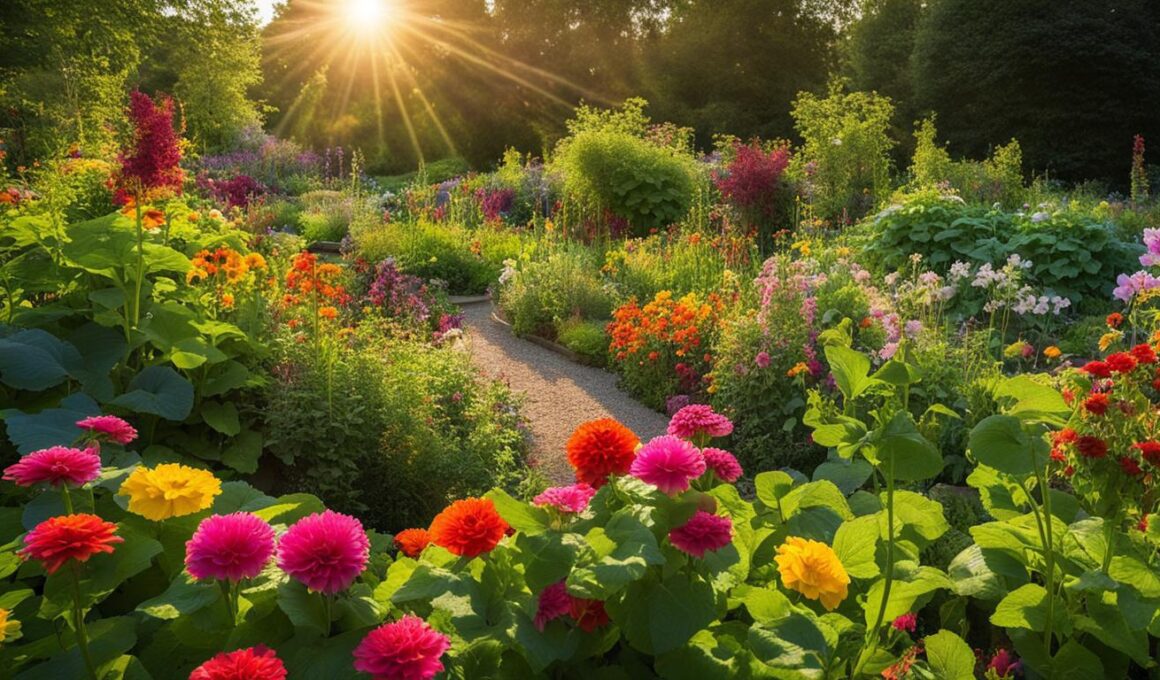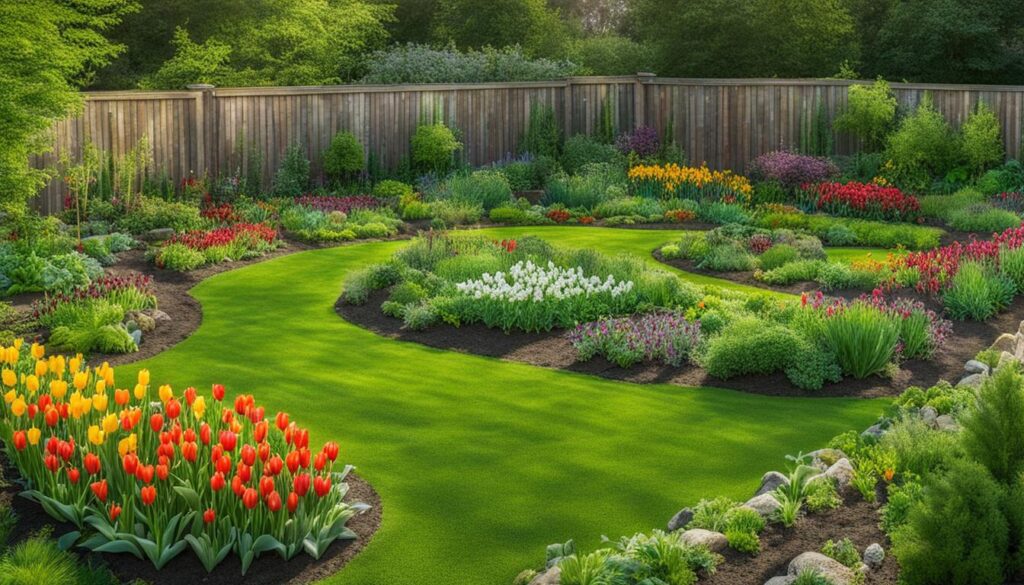Vegetable gardens have long been associated with functionality rather than aesthetics. However, adding flowers to your vegetable garden can enhance its beauty and create a visually pleasing space. Not only will your garden become a charming oasis in your backyard, but it can also boost yields and attract beneficial insects. In this article, we will explore the ways in which flowers can transform your vegetable garden into a vibrant and productive haven.
Key Takeaways:
- Incorporating flowers in your vegetable garden enhances its beauty and adds a touch of nature’s charm.
- Flowers can attract beneficial insects, which can help with pollination and pest control.
- By mixing veggies and flowers, you can create attractive plantings that are both visually pleasing and beneficial for companion planting.
- Consider adding spring bulbs to your vegetable garden beds for early season color.
- Creating a cut flower garden in raised beds allows for easy maintenance and the ability to harvest vibrant bouquets.
The Power of Spring Bulbs in Vegetable Gardens
Spring bulbs are a delightful addition to any garden, and they can bring a burst of color and beauty to your vegetable beds. These bulbs, such as tulips and daffodils, are known for their early spring blooms, adding vibrant hues and a touch of nature’s charm to your vegetable garden. Planting bulbs strategically in the corners or edges of your vegetable beds allows you to enjoy weeks of stunning flowers while still reaping the benefits of your vegetable harvest.
With their vibrant blossoms, spring bulbs provide an opportunity to enhance the aesthetic appeal of your vegetable garden beds. They not only attract attention but also serve as a natural indicator of the changing seasons. These early bursts of color can lift your spirits and bring joy and anticipation as the gardening season begins. Plus, the presence of these beautiful blooms can attract beneficial insects to your garden, helping to maintain a healthy ecosystem and boost pollination for better vegetable yields.
“Spring bulbs bring early color and beauty to vegetable gardens, creating a visual delight for gardeners and visitors alike.”
Planting bulbs in your vegetable garden is relatively easy. Simply choose the varieties that suit your region and climate, and follow the planting instructions provided by the bulb supplier. Typically, bulbs are planted in the fall before the ground freezes, allowing them to establish their roots and prepare for spring growth. By taking the time to incorporate spring bulbs into your vegetable garden beds, you can enjoy the early season beauty they bring and make your garden a true delight for the senses.
| Vegetable Garden Benefits of Spring Bulbs | How to Plant Spring Bulbs |
|---|---|
|
|
Creating a Cut Flower Garden in Raised Beds
If you have always dreamt of becoming a flower farmer and want to bring vibrant bouquets into your space, consider creating a raised bed cut flower garden. Raised beds provide an organized and controlled environment for growing flowers, making it easier to tend to and harvest beautiful blooms. Not only will you have a stunning garden, but you’ll also have a constant supply of fresh flowers to enjoy or share with others.
One of the advantages of a raised bed cut flower garden is that it allows you to experiment with different flower varieties on a smaller scale. You can choose from a wide range of flowers that thrive in raised beds, such as zinnias, cosmos, sunflowers, and dahlias. These colorful blooms will add charm and elegance to your outdoor space, creating a picturesque setting.
When planning your raised bed cut flower garden, consider the height and color combinations of the flowers. Plant taller varieties at the back of the bed and shorter ones in the front to create depth and interest. You can also mix different flower colors for a vibrant and eye-catching display. Don’t be afraid to get creative and experiment with different flower arrangements to create unique and stunning bouquets.
| Flower Variety | Height | Color |
|---|---|---|
| Zinnias | 1-3 feet | Mixed colors: red, pink, orange, yellow, white |
| Cosmos | 3-6 feet | Mixed colors: pink, white, purple |
| Sunflowers | 3-10 feet | Yellow, orange, red |
| Dahlias | 1-6 feet | Various colors: red, pink, purple, yellow, white |
Remember to provide adequate care for your raised bed cut flower garden. Water your plants regularly, especially during dry periods, and fertilize them with a balanced flower fertilizer to promote healthy growth and abundant blooms. Remove any weeds or spent flowers to keep your garden looking neat and tidy.
With a raised bed cut flower garden, you can indulge in your passion for flowers and create vibrant bouquets right in your own backyard. Enjoy the beauty and fragrance of your blooms and share the joy with others by gifting them with stunning bouquets from your garden.
Mixing Veggies and Flowers for Aesthetically Pleasing Plantings
While the primary goal of a vegetable garden is to grow food, there’s no reason why it can’t be visually appealing as well. By mixing veggies and flowers in your garden, you can create attractive plantings that add colorful pops of beauty to your outdoor space. Reserving space at the ends and corners of your vegetable beds for flowers is a great way to achieve this harmonious blend.
Integrating annual flowers alongside your vegetables not only adds visual appeal but also attracts beneficial insects that can help with pollination and pest control. This concept, known as companion planting, creates a mutually beneficial environment where flowers and vegetables coexist in harmony. For example, marigolds are known to repel harmful insects, while also adding a vibrant burst of orange and yellow to the garden.
“Mixing flowers in with your vegetable garden not only enhances the beauty of your space, it also provides numerous benefits. Flowers can attract pollinators, deter pests, and create a more balanced ecosystem in your garden.”
When choosing flowers to mix with your veggies, consider their growing requirements and compatibility. Opt for flowers that have similar light, water, and soil preferences as your vegetables. This will ensure that both plants thrive and maintain a cohesive look.
Table: Examples of Flowers to Mix with Vegetables
| Flower | Benefits | Companion Veggies |
|---|---|---|
| Sunflowers | Provide shade, attract pollinators | Pumpkins, tomatoes, cucumbers |
| Nasturtiums | Repel pests, edible flowers | Cabbages, radishes, beans |
| Zinnias | Add vibrant colors, attract butterflies | Peppers, eggplants, lettuce |
| Borage | Attract bees, improve growth and flavor | Tomatoes, squashes, strawberries |
Remember to plan your garden layout carefully, taking into account the height and spread of both the flowers and vegetables. Taller plants like sunflowers or vining flowers can be positioned towards the back of the bed, while lower-growing flowers can be placed closer to the front. This will help create a visually appealing and balanced planting arrangement.
By mixing veggies and flowers, you can transform your vegetable garden into a beautiful and productive oasis. Not only will you enjoy an abundance of fresh produce, but you’ll also be surrounded by the vibrant colors and scents of nature.
Can Low Maintenance Garden Flowers Also Be Used in Vegetable Gardens for Aesthetic Purposes?
Low maintenance garden flowers can definitely be used in vegetable gardens for aesthetic purposes. Plants like lavender, marigolds, and sunflowers not only add beauty to the garden but also help repel pests and attract pollinators. This creates a harmonious and visually appealing environment for both flowers and vegetables to thrive.
Enhancing Your Vegetable Garden with Perennial Borders and Vining Flowers
To take your vegetable garden to the next level, consider incorporating perennial borders and vining flowers. These additions not only add visual interest but also create vibrant combinations that will make your garden truly stand out.
Perennial Borders
Planting perennial flowers as a border around your vegetable garden is a smart way to add depth and color. Perennials provide a buffer zone that extends the peak blooming period of your garden, ensuring there’s always something beautiful to enjoy. Choose a mix of flowers with different heights and colors to create an eye-catching display.
Some popular perennial options for border gardens include lavender, coneflowers, daylilies, and salvia. These hardy plants require minimal maintenance and will return year after year, adding a touch of elegance to your vegetable garden.
Vining Flowers
Add height and decorative elements to your garden by growing vining flowers on trellises or supports. Vining flowers not only take advantage of vertical space, but they also create a lush and captivating backdrop for your vegetable beds. Consider varieties like morning glories, clematis, and sweet peas, which produce colorful blooms and intertwine beautifully.
By combining vining flowers with your vegetables, you’ll create a stunning contrast of textures and colors. Just make sure to provide adequate support and train the vines in the desired direction for a more organized and visually pleasing effect.
Whether you choose to plant perennial borders or vining flowers, these additions will enhance the aesthetic appeal of your vegetable garden. The vibrant combinations of colors and textures will provide a picturesque backdrop for your homegrown produce, making your garden a delightful place to spend time.
FAQ
Can I add flowers to my vegetable garden?
Yes, adding flowers to your vegetable garden can enhance its beauty and attract beneficial insects.
What are some ideas for adding flowers to a vegetable garden?
You can plant spring bulbs for early season color, create a dedicated cut flower garden in raised beds, reserve space at the ends and corners of vegetable beds for flowers, or incorporate perennial borders and vining flowers for visual interest.
How can spring bulbs enhance a vegetable garden?
Spring bulbs provide a pop of color in the early gardening season and can be planted in corners or edges of vegetable beds for weeks of beautiful blooms.
How do I create a cut flower garden in raised beds?
Raised beds provide an organized and controlled space for growing flowers, making it easier to tend to and harvest vibrant bouquets. Explore different flower varieties that thrive in raised beds.
Why should I mix veggies and flowers in my garden?
Mixing veggies and flowers adds beauty to your garden, attracts beneficial insects, and provides a balanced planting. It also allows for companion planting and similar lifespans.
How can I enhance my vegetable garden with perennial borders and vining flowers?
Planting perennials as a border around your vegetable garden extends the peak color and interest. Growing vining flowers on trellises adds height and decorative elements to maximize your planting area.










